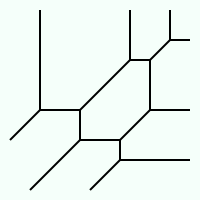Tropical geometry

Okay kiddo, let's talk about tropical geometry! It's a way to study shapes and figures that uses math to understand them better.
First, let's talk about what a shape is. You know when you draw pictures of trees, or houses, or animals? Those are all shapes! All shapes have different parts, like lines, curves, corners, and angles.
Now, imagine you could take a shape and turn all of its parts into points. The points would still show where the parts of the shape are, but they wouldn't have any of the curves or angles. That's what tropical geometry does - it turns shapes into a bunch of points.
But wait, there's more! When tropical geometry turns a shape into points, it also changes the way you measure distances and sizes. Normally, we use things like rulers and measuring tapes to see how big or far apart things are. But with tropical geometry, it's like you're using a different kind of measuring tool. This tool only measures how many steps it takes to go from one point to another. So even though the shape is now made up of points, we can still talk about how big or far apart things are.
Now this might sound strange, but sometimes when we turn a shape into points using tropical geometry, the points look like they're arranged in a pattern. This pattern can show us something about the shape itself. We can find out if the shape is symmetrical, or if it has any special properties.
Overall, tropical geometry is a really cool way to study shapes and understand them better. By turning shapes into points and using a different way of measuring, we can learn more about how shapes are put together.
First, let's talk about what a shape is. You know when you draw pictures of trees, or houses, or animals? Those are all shapes! All shapes have different parts, like lines, curves, corners, and angles.
Now, imagine you could take a shape and turn all of its parts into points. The points would still show where the parts of the shape are, but they wouldn't have any of the curves or angles. That's what tropical geometry does - it turns shapes into a bunch of points.
But wait, there's more! When tropical geometry turns a shape into points, it also changes the way you measure distances and sizes. Normally, we use things like rulers and measuring tapes to see how big or far apart things are. But with tropical geometry, it's like you're using a different kind of measuring tool. This tool only measures how many steps it takes to go from one point to another. So even though the shape is now made up of points, we can still talk about how big or far apart things are.
Now this might sound strange, but sometimes when we turn a shape into points using tropical geometry, the points look like they're arranged in a pattern. This pattern can show us something about the shape itself. We can find out if the shape is symmetrical, or if it has any special properties.
Overall, tropical geometry is a really cool way to study shapes and understand them better. By turning shapes into points and using a different way of measuring, we can learn more about how shapes are put together.
Related topics others have asked about:
